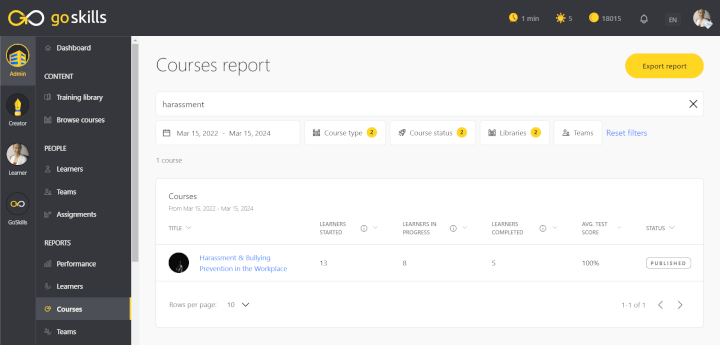Remember when employee training meant sitting in a classroom? Or when dial-up would screech? Employee learning and development has come a long way. Given the advantages of employee elearning programs, they have now become the preferred method of knowledge sharing for many companies. Let's rewind:
- 1990s: Text-based labyrinths opened up new ways to learn.
- 2000s: Learning became more interactive; lectures turned into brain-themed amusement parks.
- 2010s: The world shrank to fit on a screen as Massive Open Online Courses (MOOCs) became "all-you-can-eat" information buffets.
- Today: AI makes learning fit the learner's brain, like abilities for textbooks.
- Future: Get ready for virtual public speaking, VR dissections, and AR walks of Rome.
Online learning has changed a lot, and it will continue to evolve at a rapid rate. According to recent statistics, online education will be worth $239 billion worldwide by 2027. The industry has been steadily making more money for the past ten years, at a growth rate of about 9.5% CAGR. In the long run, Statista sees it reaching $239 billion by 2027, up from $166 billion in 2023.
In today's world of fast-changing information, learning methods that stay the same will not work. Improving and expanding these methods is essential for the best learning results across all fields and populations.
By using new methods, educators and instructional designers can help people understand things better, create personalized learning paths, and become more involved. This forward-thinking method makes it possible for skilled individuals, flexible workplaces, and prepared communities to deal with challenging problems.
Learning and development (L&D) specialists have the power to eliminate old ways of doing things and use the power of learning and growth to change things.
How people learn
Do you learn best by seeing things? Do you love charts and videos? Or are you someone who learns best by listening and loves talks and discussions?
Technology can show instructors what learners like so that they can make lessons more personalized. Tasks and quizzes are like taste tests when it comes to performance. Did a learner ace a test in below-average time? It might be time for a tougher problem. This helps instructors and administrators adjust the difficulty of the content so that learners don't get bored while learning.
Engagement
Are some learners having trouble focusing on the task at hand? Metrics such as time spent on a lesson, average test score, as well as drill-down details for each learner can give instructors and administrators insights into whether the course content and instruction methods are effective, and how engaged learners are.

This isn't just about cool tech. Data can be like a helpful sous chef that helps instructors figure out what learners need and create an enhanced learning experience. They work together to ensure your educational path is as sweet and rewarding as that freshly baked cake.
This article will explore new and improved strategies that transcend into more compelling online learning. We will cover the fundamentals of online learning; new techniques, tools, and technologies for advanced instruction; how to overcome challenges; and some case studies and examples.
Moving beyond the basics
Designing effective online training programs starts with:
- Setting SMART goals: Figure out what the learner wants to learn, and why. Set clear learning objectives so your learners know what skills they will gain when they complete the material, and how that gets them to their longer-term goals.
- Active, not passive, learning: Get them to do more than watch videos. Encourage writing things down, asking questions, and using what they learn.
- Focus: Using timers and minimizing distractions during study time is a good idea. Self-paced learning is a great way for learning to take place when and where learners are ready.
- Community: Emphasize team spirit and create a support system. Let learners know that help is available from instructors, L&D personnel, and other learners.
You have tech on your side. The tools within the learning management system (LMS) used to deploy training—such as personalized suggestions, progress tracking, and periodic updates–can help learners learn in a way that fits their needs. Gamification (the addition of game elements to make learning more enjoyable) is a popular way of increasing learner engagement.

Many, if not most, LMS platforms use various instructional design models like ADDIE and Bloom's methodology to develop learning programs or curricular courses. Once you know these basics, you'll be ready to move on to the following practical steps for an outstanding online learning program for your team.
1. Establish and maintain foundational skills
Mastery learning is like building a strong castle with solid foundations. You don't just add pile blocks on top of each other. You need to ensure that each foundational brick is stable before building on previous knowledge. In this way, your learners’ understanding will be strong when new information is added.
Why does this matter?
It’s not just about remembering things. It’s about understanding what they mean. In other words, your learners can apply what they've learned in the real world.
- Better ways to solve problems: When you start with a strong base, your learners can handle problems better. It's like having a toolbox equipped with skills they can use.
- Confidence boost: It feels great to master something. Your learners will feel like they can keep learning and growing because of it, and are in a better position to take on new challenges.
- Learning for life: Having a positive view of education promotes a culture of learning, which is a tremendous win for the learner as well as the organization.
Skill mastery is like putting together a learning castle, one brick at a time. For example, GoSkills publishes a monthly Excel challenge to help Excel learners continue to practice the skills they’ve acquired and build mastery. Learners can opt-in to receive their monthly challenge email and keep their skills sharp.
2. Create personalized learning paths for adaptive learning
Imagine attempting mountain hiking for the first time. Would your journey be the same as a skilled climber? Unlikely.
Customized learning tracks are like trails made for each learner. They're like a personalized map that leads them through fun and exciting tasks and challenges at their own pace, and with their goals.
3. Enable collaborative learning and community engagement
Learning is like going up and down the stairs. Some people start at the bottom, while others can start at the second or third step. There are people who move quickly, and people who move a bit more slowly. However, what if everyone worked together instead of against each other?
That’s collaborative learning. Some ways to encourage it include:
- Getting learners to share tips among themselves
- Soliciting different methods of solving problems
- Having fun
Collaborative learning and community involvement can take their learning to the next level. You can do great things if you work together and take small steps. Leaderboards, team points, and other forms of social learning encourage friendly competition and interaction among learners, fostering a sense of belonging and mutual support. This social dimension of learning not only motivates individuals to push their boundaries but also promotes the sharing of diverse ideas and perspectives.
By engaging in discussions, group projects, and peer feedback, learners can deepen their understanding of the subject matter and develop essential soft skills, such as communication, teamwork, and problem-solving. Ultimately, integrating these elements into the learning experience can transform education from a solitary endeavor into a dynamic, communal journey, enriching the educational journey for all participants.
Mastering online instructional design
Online learning isn't like classroom learning. Personalized learning paths, AI assistants, and brain-training tools have uncovered the holy grail. Getting employees to learn new ideas and have fun while doing it can now be achieved by instructional designers and L&D professionals responsible for organizational training and development.
Ready to learn how? Create a free GoSkills account and explore how you can create a learning program that’s engaging for your learners and fun for you.
A better way to train
It's easier than ever to create, track, and manage team training with the GoSkills LMS.
Start for free



